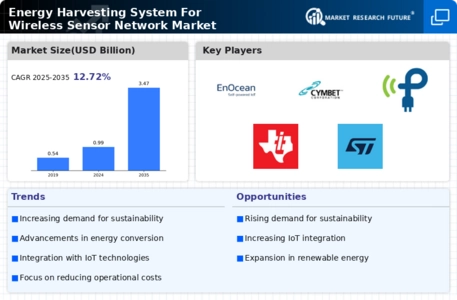Advancements in Sensor Technology
Technological advancements in sensor technology are likely to play a pivotal role in the Energy Harvesting System For Wireless Sensor Network Industry. The development of smaller, more efficient sensors enables the integration of energy harvesting systems in a wider array of applications. For instance, the emergence of ultra-low-power sensors allows for prolonged operation without the need for frequent battery replacements. This shift not only enhances the functionality of wireless sensor networks but also aligns with the growing demand for sustainable energy solutions. As sensor technology continues to evolve, the energy harvesting market is expected to expand, with projections indicating a potential market size of over 1 billion USD by 2026. This growth underscores the importance of energy harvesting systems in supporting advanced sensor applications.
Rising Demand for Energy Efficiency
The increasing emphasis on energy efficiency across various sectors appears to drive the Energy Harvesting System For Wireless Sensor Network Industry. Organizations are seeking solutions that minimize energy consumption while maintaining operational effectiveness. This trend is particularly evident in industries such as agriculture, healthcare, and smart cities, where energy harvesting technologies can significantly reduce reliance on traditional power sources. According to recent estimates, the energy harvesting market is projected to grow at a compound annual growth rate of approximately 12% over the next five years, indicating a robust demand for innovative energy solutions. As businesses strive to meet sustainability goals, the adoption of energy harvesting systems is likely to become a standard practice, further propelling the industry forward.
Integration with Smart Infrastructure
The integration of energy harvesting systems with smart infrastructure is emerging as a key driver for the Energy Harvesting System For Wireless Sensor Network Industry. As cities evolve into smart cities, the demand for efficient energy solutions becomes paramount. Energy harvesting technologies can power various applications, including street lighting, environmental monitoring, and traffic management systems, without relying on conventional power sources. This integration not only enhances operational efficiency but also contributes to the overall sustainability of urban environments. The market for smart infrastructure is projected to reach approximately 2 trillion USD by 2025, indicating a substantial opportunity for energy harvesting systems to play a critical role in this transformation.
Government Initiatives and Regulations
Government initiatives aimed at promoting renewable energy sources and reducing carbon footprints are influencing the Energy Harvesting System For Wireless Sensor Network Industry. Various countries are implementing regulations that encourage the adoption of energy-efficient technologies, including energy harvesting systems. These initiatives often include financial incentives, grants, and subsidies for businesses that invest in sustainable energy solutions. As a result, organizations are increasingly integrating energy harvesting technologies into their operations to comply with regulatory requirements and benefit from available incentives. The cumulative effect of these government policies is expected to drive significant growth in the energy harvesting market, with estimates suggesting a potential increase in market value by 15% over the next few years.
Growing Adoption of Wireless Technologies
The growing adoption of wireless technologies is significantly impacting the Energy Harvesting System For Wireless Sensor Network Industry. As industries increasingly shift towards wireless communication for data transmission, the need for reliable and sustainable power sources becomes more pronounced. Energy harvesting systems provide a viable solution by enabling wireless sensor networks to operate independently of traditional power sources. This trend is particularly relevant in sectors such as logistics, healthcare, and environmental monitoring, where continuous data collection is essential. The wireless sensor network market is expected to grow at a rate of 10% annually, further highlighting the potential for energy harvesting systems to support this expansion. Consequently, the energy harvesting industry is likely to experience substantial growth as it aligns with the wireless technology trend.

















Leave a Comment